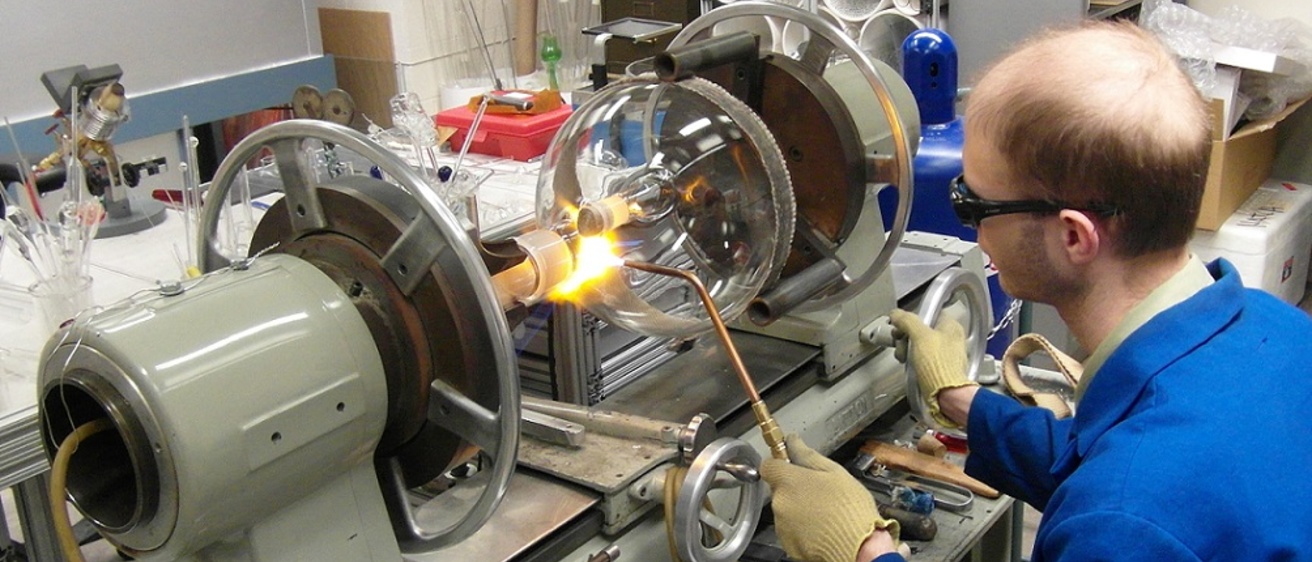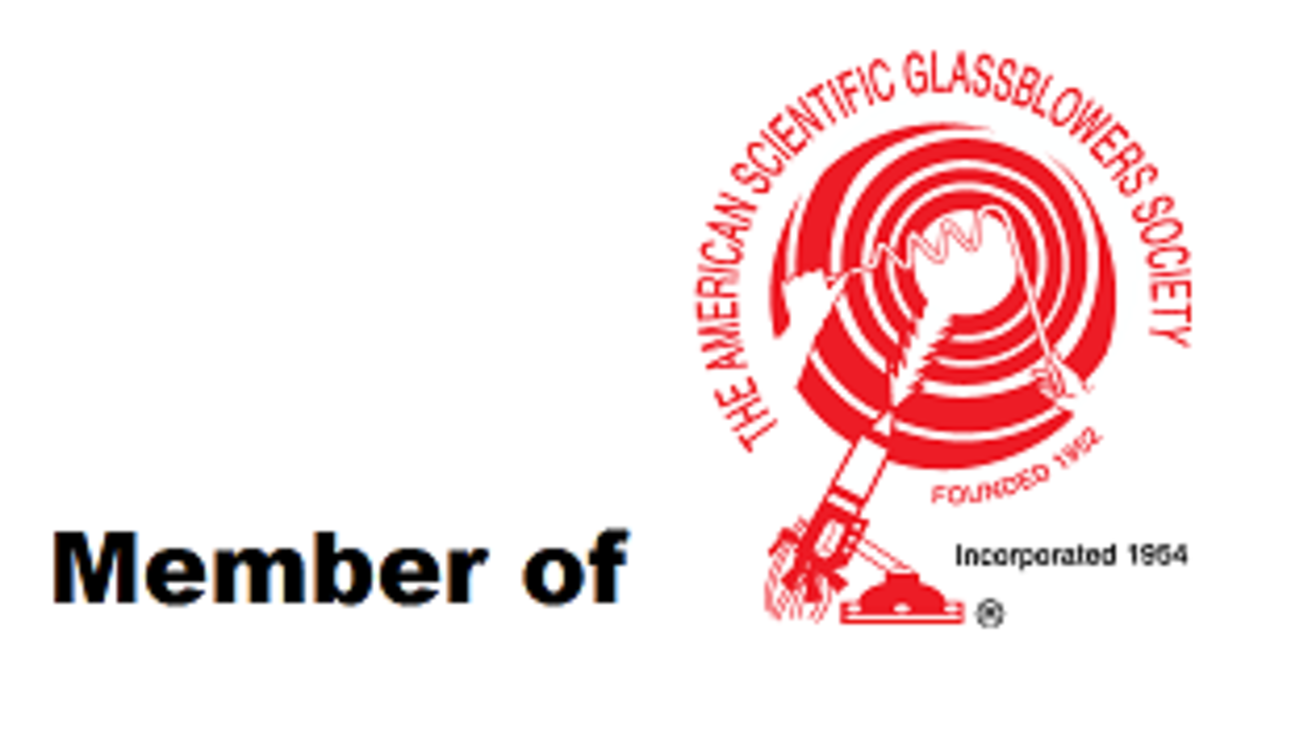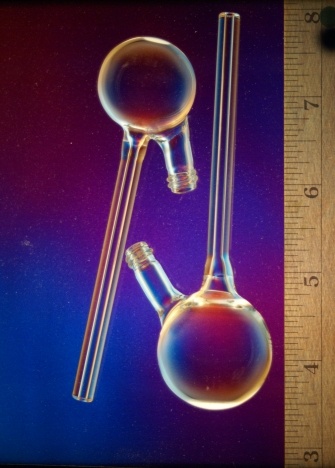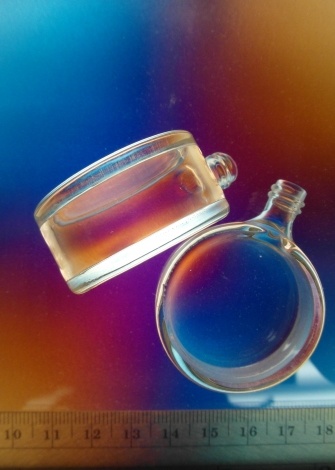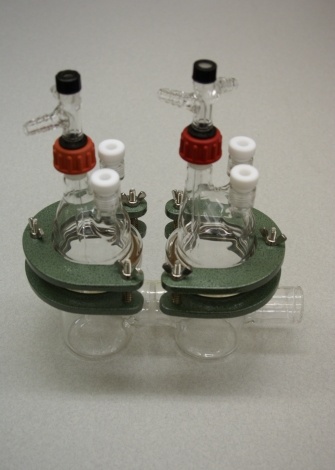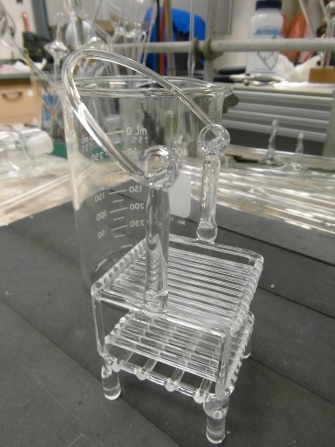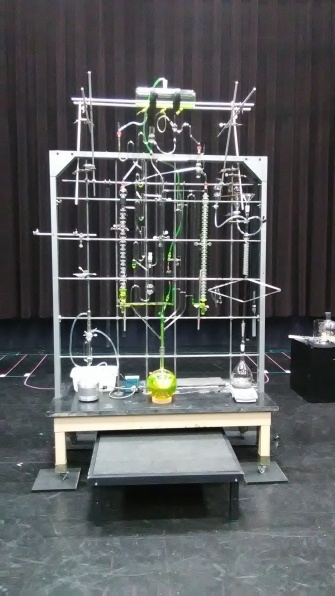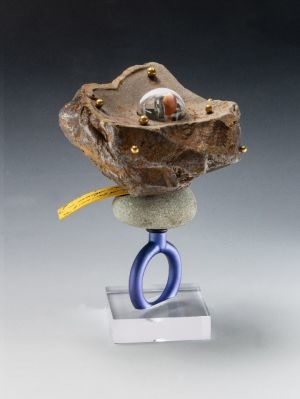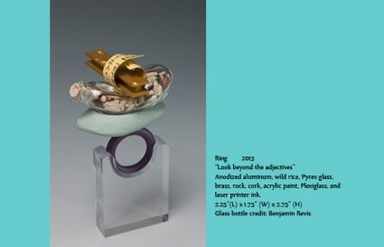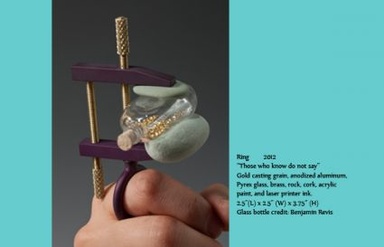Main navigation
A scientific glassblowing facility is an indispensable part of any modern research team. The Glass Facility, found within the Department of Chemistry, is responsible for assisting in the design and fabrication of all glass scientific equipment, as well as repair of existing equipment.
Services provided
- Design and construct custom glass scientific apparatus
- Repair of existing equipment
- Contract work for users outside of the Department or University
Common materials worked with
- Pyrex, Kimax, Simax (Borosilicate) sizes 1mm - 100mm tubing up to limited short lengths of 160mm maximum diameter
- Quartz (Fused Silica) sizes 1mm - 30mm tubing
Glass to metal seals Electrode through wires (tungsten, platinum, gold
For anything else please contact the Glass Facility for details
Contact us
Benjamin Revis, Glassblower
Facility Hours: 9am - 4:30pm
Consultation times available walk-in or by appointment.
Location: W152 Chemistry Building (CB)
Phone: 319-335-1337
Fax: 319-355-1270
Email: benjamin-revis@uiowa.edu
Facility tools & capabilities
This is a list of the primary tools in the Glass Facility with general working parameters given, but don't let that dissuade you from inquiring about a seemingly challenging job.
Tubing
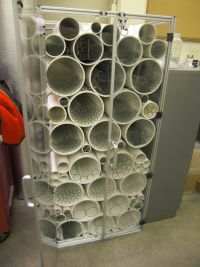
A wide range of borosilicate tubing is kept on hand ranging from 1mm - 160mm Outer Diameter. Also a small selection of capillary tubing is on hand with Inner Diameters of 0.5mm - 2mm. Should your Project need specialty tubing (e.g. Profile Tubing: Square, rectangular, scalloped, etc.), or special wall weight requirements, the Glassblower will work with you to order what is needed.
Some Fused Silica stock material is also kept on hand for those high temperature or UV needs. Due to the low demand for fused silica, less is on hand but can be ordered as needed. Current facility capabilities can accommodate fused silica outer diameters up to 2 inch (50mm).
Glass lathe
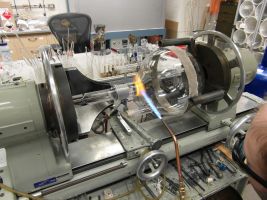
The Facility has a Litton HSJ lathe with a through bore capacity of 100mm and a bed length of approximately 24 inches (60.8cm). The chuck jaws can accommodate up to a 5000mL Round Bottom Flask, as seen in the image on the right.
Diamond cutoff saw
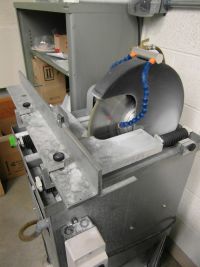
Precision cutoff saw is equipped with a fourteen inch diamond-resin blade. The blade having an approximate 2mm curf. The saw table is configurable to accommodate various angles, specified lengths and depths to be cut.
Lapping wheel
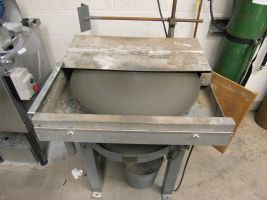
The Eisler Engineering Co., Inc. Lapping Wheel has a 24 inch wheel. Through the use of various silicon carbide grit powders with water, or diamond grit pads flat grinding and faceting are achieved.
Small scale mill-lathe combo
This hobby mill/lathe combo unit is primarily used to fabricate various basic graphite tools used in the manipulation of certain glass techniques. Current experimentation is being conducted to determine what level of glass machining may be capable. If you are interested in some basic non-precision glass machining, the Glass Facility is open to discuss opportunities.
Annealing oven
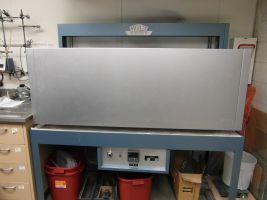
Wilt bell-type oven with a 5 foot (L) x 1.5 (W) x 1.75 (H) foot internal cavity designed primarily for annealing borosilicate glass but may be programmed for other light purposes (as approved by the Glass Facility).
Instruction & resources
Scientific Glassblowing Fundamentals
History of Glassblowing Course at Iowa
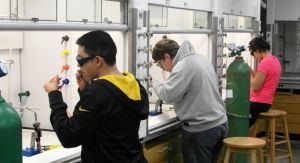
1According to the General Catalogs the first entry for "Elements of Glass Blowing" is found in the 1922-23 academic year, the year the Chemistry Building was opened. The course number was 184 with a 1 semester hour credit. "Elements of Glass Blowing" was tought by Ronald Johnson (Glassblower 1922-25) until he left the University in 1925. J.W. Robins (Glassblower 1925-30) continued teaching the "Elements" course (184) from 1925-29. In the academic year 1926-27, possibly due to popularity of the course, a second section was added 183. Frank Long (Glassblower 1930-34) began teaching the courses from 1929-33. In 1933-34, Herman Wiegand (Glassblower 1934-1950) taught "Elements of Glass Blowing," and in 1943-44 the course name was changed to "Glassblowing," and the course numbers were now 4:183 and 4:184. Wiegand taught the course through the 1949-50 academic year. Harry Nunamaker (Glassblower 1950-61) began teaching "Glassblowing" in fall 1950, when the course number was listed as 4:183 only. Nunamaker taught the course through 1961. John Coutant (Glassblower 1962-77) taught "Glassblowing," course number 4:183 only in the academic year 1962-63. There is no further record of the course being taught again until the Winter Session 2013 (January Term).
The "Scientific Glassblowing Fundamentals" course is currently offered in the Winter session, taught by Benjamin Revis (Glassblower 2011-present). The intent of the course is not to make proficient glassblowers out of every student, but to expose them to the Scientific Glass fabrication process. With this experience the student should walk away with a better appreciation for the behind the sceans support industry that is Scientific Glassblowing. Some may even need to call on their experiences later in life when they get out into the research field or industry where they may need to perform a minor repair or at the least communicate with a professional glassblower informing them of their research needs.
1Credit and thanks should be given to Denise Anderson of the University of Iowa Libraries & Special Collections for helping locate and compile the course history information.
2 Photos by: Benjamin Revis
Advanced Methods in Chemical Research CHEM:3560:0001 (004:156:001)
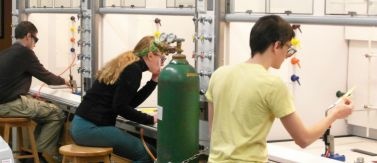
Scientific Glassblowing Fundamentals (No Longer Offered - Until Further Notice)
An introduction to the basic manipulations of Borosilicate Glass for the purpose of fabricating basic scientific apparatus. Students will learn how to pull points, join tubing together, fabricate a cold trap (bubbler), condenser, drying tube, and distillation column. The techniques learned with imaginative ingenuity can be applied to larger more complex apparatus as well as artistic representation.
Principles of Chemistry - II; Honors (CHEM: 1120)
Tour of the Glass Facility and discussion of Scientific Glassblowing applications and limitations.
Fundamentals of Chemical Measurements (CHEM: 1120)
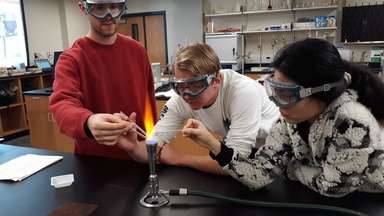
Students construct ion selective electrodes that they will use in subsequent procedures. A basic introduction of glass manipulation is taught in order to accomplish the construction purpose.
Inorganic; Lab (CHEM: 3530)
Students are exposed to the construction of a 'T', test-tube, and bubbler. With the final deliverable being a viable bubbler.
Synthesis and Measurement (CHEM: 4450)
Students are shown how to tip-off ampoules and provided a demonstration of resources and capabilities available in the Glass Facility
Resources
The Glass Facility views these resources as beneficial to the research community based on questions and consultation provided to various customers. In no way are these resources intended to promote one company over another and the compiled resources herein should not be considered exhaustive. Multimedia presented are for reference only, if you should attempt anything presented please consult your safety guidelines, policies and procedures for best practices (i.e.PPE requirements).
If you have questions or concerns regarding glassware design, use, or application, don't hesitate to contact the Glass Facility so you can get the answer(s) you need.
Resources
Online information
Ace Glass - Technical Support
Chemglass Life Sciences - Technical Data
S. I. Howard Glass Co. - Spec Sheets for various types of flat glass (BK-7, B270, filter glass, mirrors, gorilla glass, and more)
MilliporeSigma - Literature and Technical Bulletins to assist you with your Life Science and R&D needs. Browse our technical bulletins, cell culture manual and catalogs for the answers and products you need. MilliporeSigma has now put together a dedicated site to promote their partnership with the University of Iowa; Visit sigma-aldrich.com/iowa
Technical Glass Products - Technical Information relating to Fused Quartz (e.g. properties, trace impurities, transmittance curves, etc.)
Haraeus Quartzglas - Technical Information for Fused Silica, Suprasil, Infrasil, etc. A number of unique optical, mechanical and thermal properties have made quartz glass an indispensable material in the fabrication of high-tech products. Among these are: high chemical purity and resistance, high softening temperature and thermal resistance, low thermal expansion with high resistance to thermal shocks, high transparency from the violet to the infrared spectral range, high irradiation resistance.
Starna Cells - Technical Information; Manufacturers of Quality Spectrophotometer, Fluorometer, Colorimeter and Laser Cells. UV/Vis Reference Materials - NIST Traceable and non-traceable.
McMaster Carr - A wealth of technical information about the various product that they sell. Specifically various use application limitations to help the user select the appropriate components needed for a specific application.It is recommend that the researcher, research group, obtain a catalog print copy to have on the shelf. Sometimes it is easier to locate information in print vs. online.
The O-Ring Store LLC - A resource of o-ring material and information including sizing, chemical compatibility, durometer and temperature charts.
Swagelok - Swagelok Company is a global developer and provider of high-quality and reliable fluid system solutions including products, assemblies and services for the research, instrumentation, process, oil and gas, power, petrochemical, alternative fuels, and semiconductor industries.
The University of Iowa Environmental Health and Safety - The University guidence for safe work practice. The Environmental Health & Safety Office (EHS) provides services intended to promote health and safety at the University of Iowa. We offer a variety of services in the areas of Biological, Chemical, Occupational and Radiation safety, and select Environmental programs.
UI CLAS Research and Design Services - Offering prototyping, engineeering and design consultation, laser cutting, machining, electronics design assembly calibration and repair, machine maintenance and repair.
UI Physics and Astronomy Machine Shop - We have 5 CNC milling machines, 1 CNC lathe, 1 electrical discharge machine, 4 manual lathes, drill presses, saws, welding equipment, and sheet metal fabrication equipment. We have 3 different CAD programs to use in designing parts, assemblies, making mechanical drawings, and creating programs to control our CNC machines. With these CAD programs we can also view most part models or drawings that were made in a different CAD program. We have machined parts out of many different metals, plastics, and garolite materials. Some of our measuring tools are calibrated yearly by standards traceable to NIST per the guidelines specified in the latest revisions of ANSI/NCSL Z540-1 and ISO/IEC 17025.
UI Engineering Technology Services - The Engineering Technology Services (include Electonics and Machining) contains lathes, mills, band saws, and many hand tools with which to work many types of materials, including plastics, fiberglass, and metals. EMS works with students, faculty, and staff in the College of Engineering as well as people across the UI campus providing concept development, project design, and prototyping services. Students are taught how to use the equipment safely and then use the machines for class projects.
The American Ceramic Society - Since 1898, ACerS has been the hub of the global ceramics community and one of the most trusted sources of ceramic materials & applications knowledge. If ceramic material and technologies are a significant part of your work, then ACerS is the professional society for you.
American Chemical Society - The Society publishes numerous scientific journals and databases, convenes major research conferences and provides educational, science policy and career programs in chemistry. [They] also play a leadership role in educating and communicating with public policy makers and the general public about the importance of chemistry in our lives. This includes identifying new solutions, improving public health, protecting the environment and contributing to the economy.
Glas - An exuberant 1958 Oscar®-winning film about glass-blowing, automation and all that jazz. Bert Haanstra 10 MINUTES. This is not Scientific Glassblowing but is a fun video to watch.
Smithsonian Science Under Glass - The National Museum of American History's laboratory glassware collection contains more than one thousand objects dating from the 17th century to the present day. Examining the collection reveals a broader story—both about the increasing professionalization and specialization of American science and about the importance of glass as a material for scientific investigation.
Books
Shelby, J.E. Introduction to Glass Science and Technology. 2nd ed. Cambridge: The Royal Society of Chemistry, 2005. Print.
Introduction to Glass Science and Technology presents the fundamental topics in glass science and technology including glass formation, crystallisation and phase separation. A detailed discussion of glass structure models with emphasis on the oxygen balance model is also presented. Additional chapters discuss the most important properties of glasses, including physical, optical, electrical, chemical and mechanical properties, and new to this edition, water in glasses and melts. Glass technology is addressed in chapters dealing with the details of glass raw materials, melting and fining, and commercial glass production methods. This expanded second edition also includes new chapters on the compositions and properties of commercial glasses and thermal analysis of glasses and melts. Exercises are included at the end of the chapters. This introductory text is ideal for undergraduates in materials science, ceramics or inorganic chemistry. It will also be useful to the engineer or scientist seeking basic knowledge of the formation, properties and production of glass. [This text is available to The University of Iowa as an e-book; click on the hyperlinked title and you will be directed to enter your HawkID informaiton.]
Coyne, Gary S. The Laboratory Companion. Hoboken: John Wiley & Sons, Inc., 2006. Print
An updated version of the critically acclaimed Laboratory Handbook, this guide to laboratory materials, equipment, and techniques is an important resource for students as well as veteran scientists and lab technicians. From vacuum technology and glass vacuum systems to volumetric glassware, gas-oxygen torches, and cryogenic tanks, The Laboratory Companion provides complete coverage of all commonly used lab equipment, including essential information about its selection, use, cleaning, and maintenance. It clearly explains the historical development and rationale behind how and why things are done in the lab, and includes helpful guidelines and step-by-step procedures for each topic discussed. Since glassware is typically the most prevalent type of lab equipment, much of the book is devoted to the properties and handling of glass apparatus, with additional material on rubber and plastic tubing, corks, stoppers, and O-rings. Readers will also find broad coverage of measurement systems, high- and low-temperature apparatus and techniques, compressed gases, vacuum systems, and other essential subjects.
Gary S. Coyne is a scientific glassblower in the Department of Chemistry of California State university at Los Angeles.
Wheeler, E.L. Scientific Glassblowing. New York, 1958. Print
With the research point of view in mind, it seemed appropriate that a book entitled Scientific Glassblowing should have sections on subjects not even remotely related to glassblowing, for example, machine shop practices and major chemical processes such as chromatography, extraction, evaporation, and distillation. As a professional glassblower I found knowledge in these subjects both useful and interesting. A glassblower who knows the principles involved in these chemical processes and is familiar with laboritory techniques, such as those of high vacuum, is better able to make constructive suggestions in the design fo new and special apparatus. He is also better able to build the apparatus after it is designed. Furthermore, the glassblower who can make small metal parts or who can design and make electric heating units which are so often an integral part of glass apparatus, is of special value to his research group. - Excerpt from Preface Wheeler, E.L.
Documents, PDFs, Images
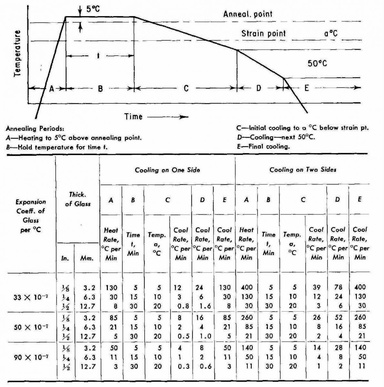
Annealing Profile Chart - Generic approximation for getting started. To determine anneal scheduling properly it is recommended to perform various test runs, varying soak times and temperatures with followup observation with control parameters and a polariscope to view stress distribution. (this link is not recommended for citation purposes)
Keithly Low Level Measurements Handbook - 7th Edition - A quick highlight of this handbook includes: Theoretical Measurement Limits; Understnding Instrument Specifications; Circuit Design Basics; Measurements for High Resistance Sources; Measurements for Low Resistance Sources; Low Level Instrument Selection Guide. The hanbook can also be found at: Tektronix/Keithley Instruments Knowledge Center
Parker O-ring Handbook - This book contains extensive information about the properties of basic sealing elastomers, as well as examples of typical o-ring applications, fundamentals of static and dynamic seal design and o-ring failure modes. It also provides an overview of international sizes and standards, and compatibility data for fluids, gases and solids.
Swagelok Ultra-Torr Vacuum Fittings - O-ring compression coupling to glass, metal, or plastic tubing. Tubing sizes from 1/16 to 1 1/2 inch.
Swagelok KF Vacuum Fittings - Adapter Fittings to go from KF to VCO, VCR, NPT, Swagelok Tube, and Ultra-Torr
Outreach
Outreach
Engaging the community and the next generation showing that glass technology, old as it may be, is still developing, changing and impacting our world today and in the future. Just take some time to think about how glass impacts your life every day, you might be surprised.
If you are interested in a tour or demonstration, please contact the Glass Facility to arrange a time.
2024 Tours/Demonstrations
January 26th - Marion Home School Assistance Program
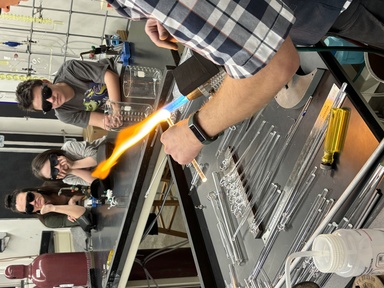
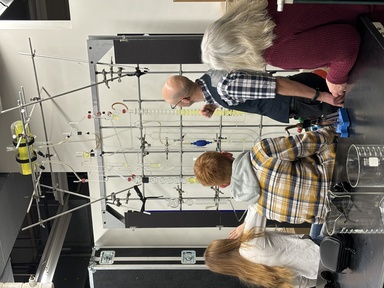
"FIVE fun and informative presentations on scientific glass blowing. We were intrigued by the variety of examples of the creations you made. It was interesting to learn about the trombone and mute as well. The children enjoyed watching you create an item and answering their many questions along the way. The clock was among the highlights of their day as well." - Sally Hoffman on behalf of the Parents and Students of the Marion Home School Assistance Program
Photo Credit: Melissa Siewert
2019 Tours/Demonstrations
October 27th - Scientific Concert; collaboration with School of Music, Public Digital Arts Cluster, Physics and Astronomy, Earth and Environmental Sciences, Geological Survey, and Chemistry. Learn more about this project.
2018 Tours/Demonstrations
April 27th - Science Night Echo Hill Elementary, Marion, Iowa
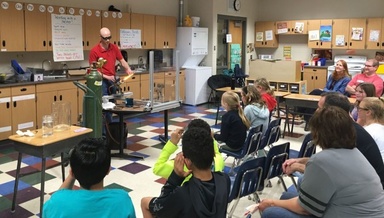
April 8th - Musical Chemistry; Collaborative performance with Jean-Francois Charles from the School of Music. Learn more about this project.
March 6th - Faith Academy 3rd Grade
"Thank you so much for allowing us to visit your glassblowing studio. This experience really enriched the scholars' learning. They couldn't stop talking about it. We felt very lucky to be able to come and observe you demonstrate glassblowing!" Sincerely, Mrs. DeLange (Faith Academy 3rd Grade Teacher).
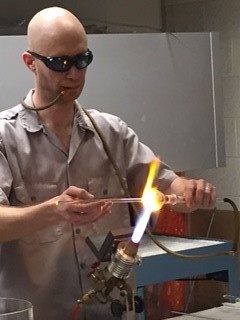
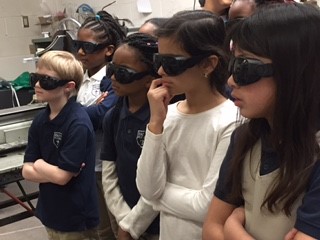
Read letters from the scholars after visiting the Glassblowing facility.
2017 Tours/Demonstrations
April 6th - Montessori of Iowa City
A Special Thank You!
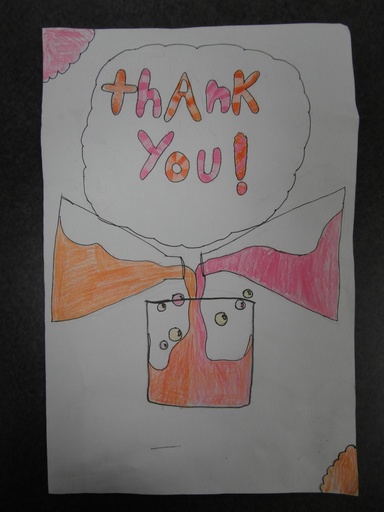
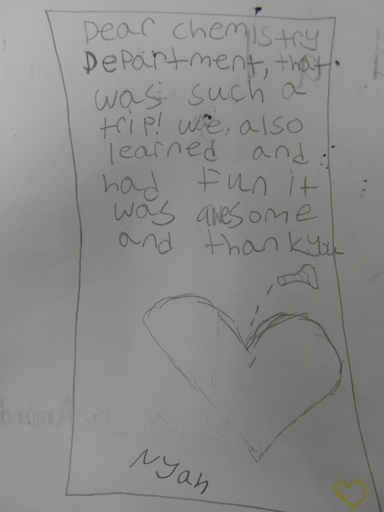
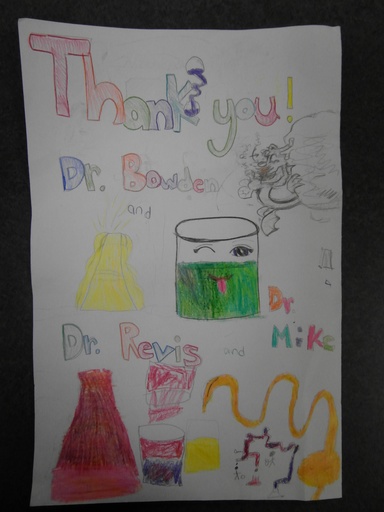
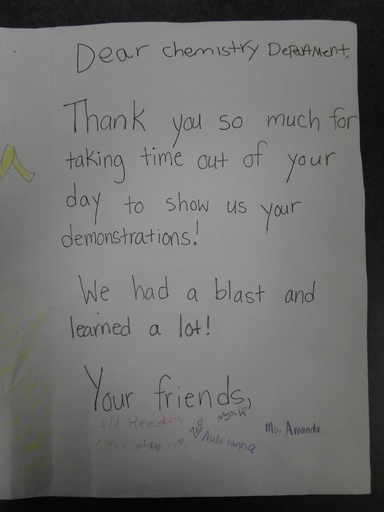
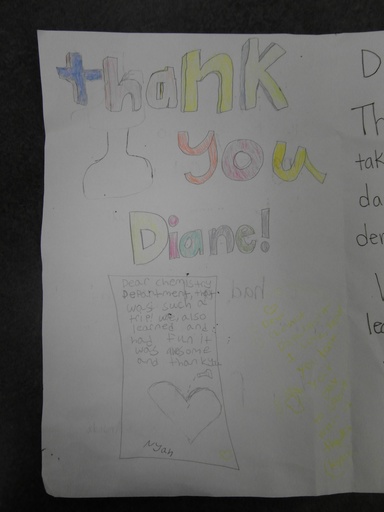
April 21st - Science Night Echo Hill Elementary, Marion, Iowa
June 5th - Lifelong Learning Program - The University of Iowa Alumni Association
2014 Tours/Demonstrations
December - Faith Academy Second Grade
Jan Hochstetler - Second Grade Teacher
The Second Grade class had learned about the Venetian Glassblowers as part of a History lesson and they wanted to come learn more about glass, glassblowing, and the manipulation of glass. The students enjoyed seeing Mr. Revis pull a string of glass accross the room, blow a glass bubble, and wind a glass coil right in front of them! They learned about the type of work that glassblowers can do and also enjoyed getting to be on our University’s campus.
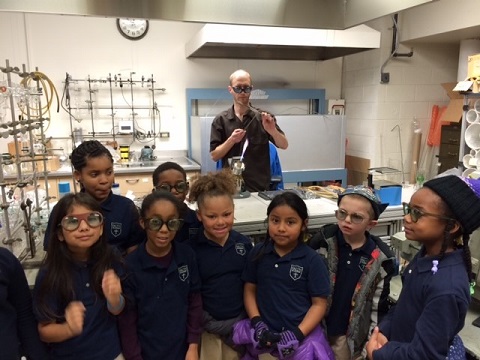
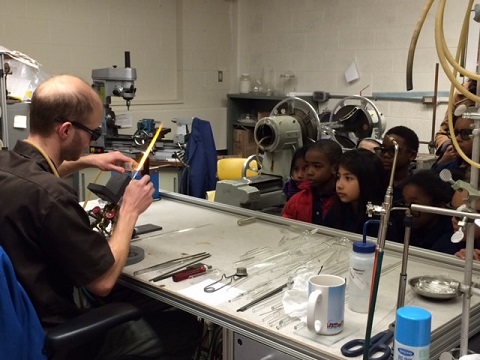
Collaborations
Given the opportunity the Glass Facility enjoys collaborating on various Campus and Community projects ranging from artistic pieces to Community Education and Outreach.
Collaborations
Charles, Jean-Francois - Sounds of Water
Charles, Jean-Francois - Sounds of Water (August 2022) Piano, wet percussion instruments, vibraphone, waterphone, base clarinet, ice, waterclock;Scientific Concert (October 2019) Links to video recordings: Petrasonic, Aeris; Aqua Ignis; Musical Chemistry (April 2018), Custom Glassware along with repurposed laboratory ware used as musical accompaniment. Instruments made: Udu; Chimes; Bells; Rijke tubes; Rain Stick; Klein bottle shaker; and an 8 foot tall Gitton Water Clock (replica). IowaNow article can be found here.
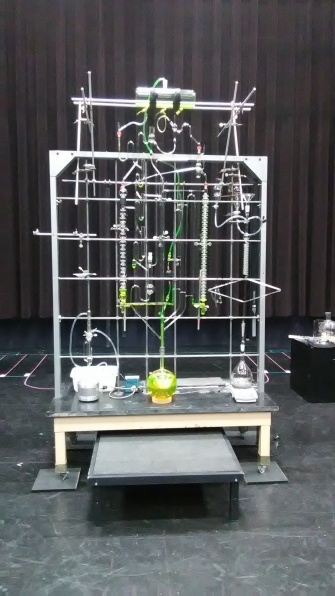
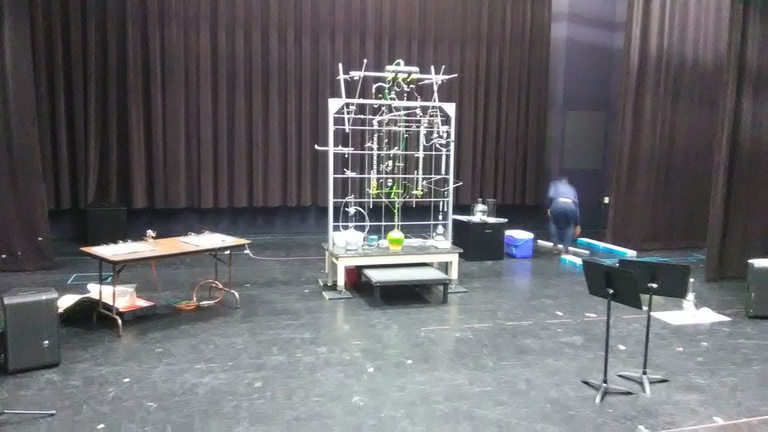
Yuen, Kee-Ho - Rings
Beadology Iowa; Summer of the Arts - Iowa Arts Festival
Beadology Iowa; Summer of the Arts - Iowa Arts Festival (Art and Science booth sponsored by Beadology Iowa)
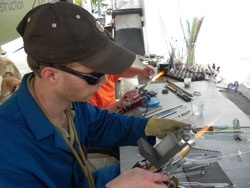
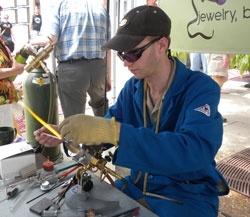
Spring 2020
Fall 2019
Quality statement
It is the intent of the University of Iowa Glass Facility to provide quality glass apparatus specifically designed to the researcher’s needs. As this is a custom and repair facility each job is uniquely evaluated to determine steps and procedures to ensure that the demands of the design are achieved.
Quality statement
Material receipt
Received materials are inspected for shipping damage by our receiving area and then the product is further scrutinized by the Glassblower to make sure the materials are in the appropriate condition for use in fabrication.
Material preparation/assembly
The preparation (if necessary) of the material to be assembled is performed in a manner to limit the amount of surface abrasion and potential of air bubbles that could be introduced into the glass material when fused together. The quality check for fusion of the glass during the assembly process is performed at the discretion of the Glassblower. The final process of material assembly is the annealing procedure. Through the annealing process, the stresses induced due to the non-uniform heating during assembly are reduced.
System compatibility
In the cases where a system of pieces are to be designed to fit or work together, the finished individual pieces are brought together to ensure proper interconnectivity and to address any unforeseen user interface issues. This process also allows for future consultation with the customer after they have received the system should they have questions regarding how the system is assembled.
Customer satisfaction
The University of Iowa Glass Facility desires that customers are satisfied in having received an apparatus that meets or exceeds their design ideas. If there was any miscommunication in the design or less than desired product received by the customer, the Glass Facility will work with the customer to correct the issue(s) to the extent that the Glass Facility is capable.
Extra requirements
As each job is evaluated individually the customer may request additional procedures to assure that they receive an apparatus that will stand up to their required needs. The Glass Facility will work with these extra requests on a case-by-case basis.
Submit a work request
Submit a request to design and construct custom glass scientific apparatus, repair of existing equipment, or contract work.
